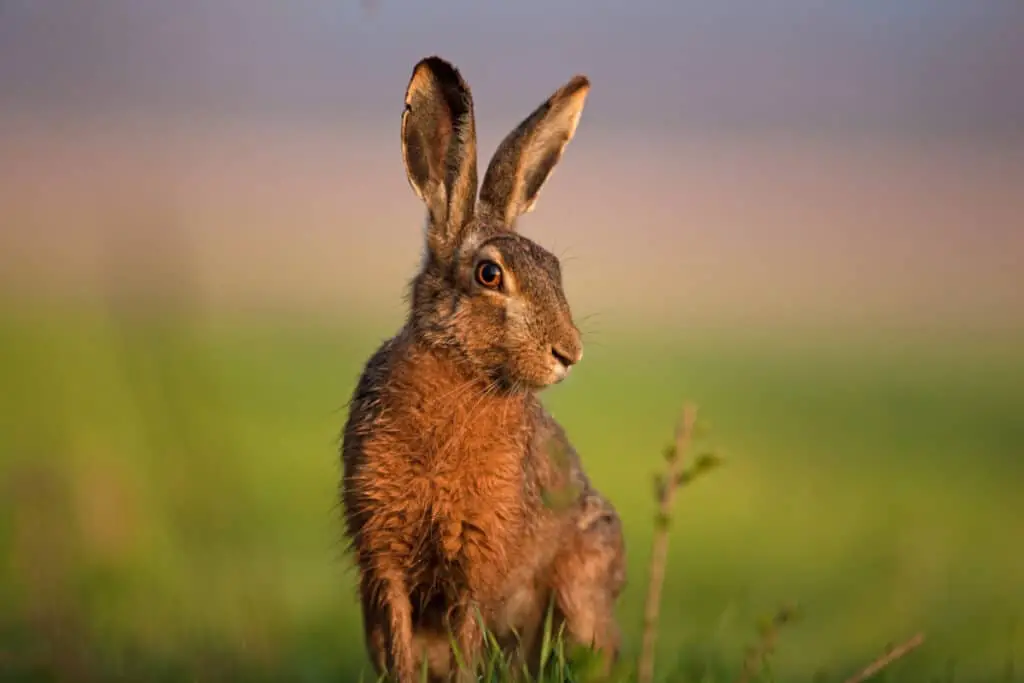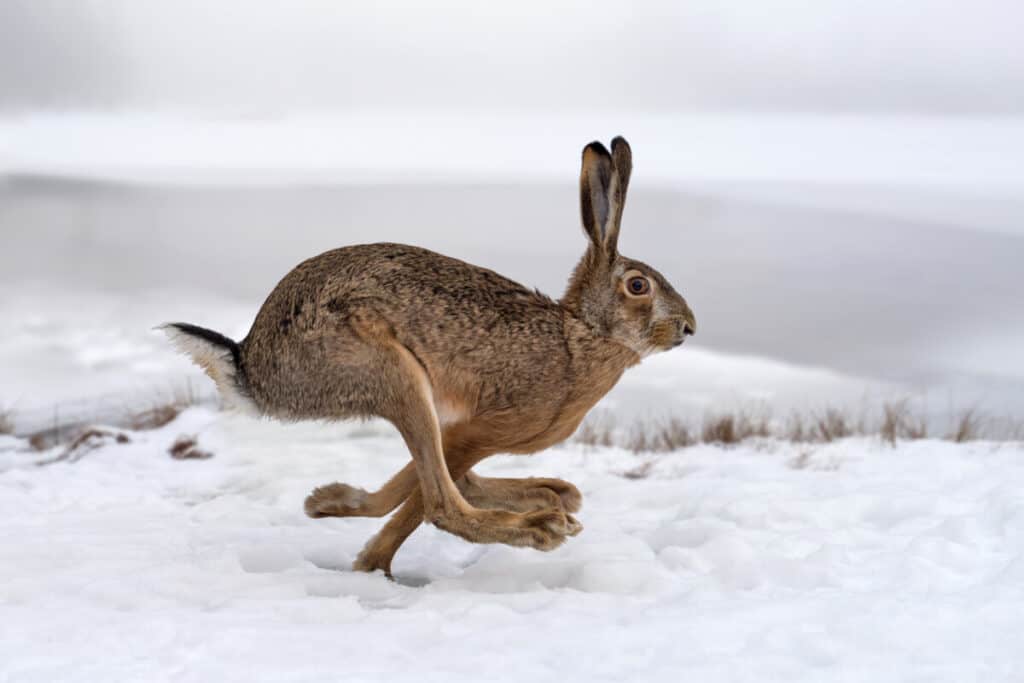The hare is a fascinating and swift mammal that has captured the attention of humans for centuries. Belonging to the order Lagomorpha, hares are known for their long ears, powerful hind legs, and distinctive hopping gait. Hares can be found in various parts of the world, including North America, Europe, Asia, and Africa.
Hares have played an important role in human culture throughout history. They feature prominently in folklore and mythology as symbols of fertility, speed, and agility. In some cultures, they are considered sacred animals or associated with deities.
Today, hares continue to capture our interest as subjects of scientific research aimed at understanding their behavior, biology, and ecology. This article will explore the characteristics of hares and shed light on their significance in various cultures around the world.

Characteristics Of Hares
With long ears that act as antennas, keen eyesight, and powerful hind legs built for speed and agility, hares have developed physical adaptations that allow them to survive in their natural habitat.
In addition to these characteristics, behavioral patterns such as living alone or in small groups and being primarily nocturnal also contribute to their survival.
Physical adaptations enable hares to navigate their environment with ease.
Their long ears help detect sounds from potential predators while their eyes provide excellent vision even during low light conditions.
Meanwhile, their strong hind legs are designed for quick movements and sudden changes of direction when running at high speeds.
These features make it easier for hares to evade danger and escape capture by predators.
Additionally, some species of hares can change color depending on the season which helps camouflage themselves from predators giving them an added advantage in surviving in the wild.
Hares and Their Predators: Unveiling the Threats
Habitat And Distribution
The habitat and distribution of hares vary depending on the species.
Generally, hares can be found in a wide geographical range around the world, from North America to Europe and Asia.
They occupy diverse habitats such as grasslands, deserts, taiga forests, and tundra regions.
Hares prefer areas with low vegetation cover which provides them with enough space to run and hide from predators.
Hares are known for their adaptability to different environments, allowing them to survive in various conditions.
Their ecological niche is critical in maintaining balanced ecosystems by serving as prey for larger animals such as coyotes, wolves, eagles, and lynx.
A change in hare populations can have significant implications for predator-prey relationships within an ecosystem.
Therefore, understanding their habitat requirements and distribution patterns is crucial for conservation efforts aimed at preserving biodiversity.
Diet And Feeding Behavior
The dietary habits of Hares are intriguing and varied. One might say that their feeding behavior is a study in adaptability, as they have evolved to thrive on various types of vegetation. However, the nutritional requirements for these animals vary depending on factors such as age, sex, reproductive status, and environmental conditions.
Hares typically feed on grasses, herbs, shrubs, bark, buds, and leaves. They also consume fruits and seeds when available. To meet their nutritional needs, hares tend to forage during early morning or late afternoon when temperatures are cooler. Furthermore, behavioral adaptations like coprophagy (the consumption of fecal pellets) allow them to maximize nutrient absorption from their food sources.
In terms of foraging strategies, it has been noted that hares use different techniques based on habitat type; for example, desert hares rely more heavily on burrowing plants while mountain hares browse at higher elevations where less grazing competition exists. Overall, the diversity of hare diets reflects their remarkable ability to exploit a wide range of resources in order to survive and reproduce.
In conclusion to this section about diet and feeding behavior in hares; It is clear that these animals have complex nutritional requirements and adaptive behaviors that enable them to thrive in diverse environments. Understanding how hares obtain energy and nutrients is crucial not only for ecological research but also for conservation efforts aimed at preserving these fascinating creatures and their habitats.
Reproduction And Life Cycle
Continuing on from the previous section, it is important to note that a hare’s diet and feeding behavior largely depends on its habitat. Generally speaking, hares are herbivores and their diets consist of grasses, herbs, leaves, bark, buds, and twigs. They also tend to consume more woody vegetation during winter months when other food sources may be scarce. In terms of feeding behavior, hares have been observed grazing for long periods of time or browsing selectively on certain plants.
Moving onto reproduction and life cycle, hares have relatively short lifespans compared to other mammals. On average they live for 3-4 years in the wild. The breeding season for most species occurs between late winter and early summer depending on location. During this time males will compete with each other for access to females through aggressive displays such as fighting or chasing one another.
After mating takes place the female will give birth to a litter of leverets which she will nurse until they are able to fend for themselves. It is worth noting that many factors including predation by predators can impact the survival rate of young hares.
- Life span:
- Hares typically live for 3-4 years.
- Some factors that may influence lifespan include availability of resources and predation risk.
- Breeding season:
- Most species breed between late winter and early summer.
- Males use aggressive displays like fighting or chasing one another to gain access to females.
- Females raise their young (leverets) until they are independent enough to survive alone.
Cultural Significance Of Hares
The hare has played a significant role in folklore across various cultures.
In European mythology, hares are often associated with trickery and cunningness.
For example, in Welsh folklore, the goddess Ceridwen is said to have transformed herself into a hare to escape from King Arthur’s hunting party. Similarly, in Germanic mythology, the trickster god Loki was believed to take on the form of a hare during his mischievous escapades.
Apart from its association with trickery, hares also hold symbolic significance in many cultures.
For instance, among Native American tribes such as the Cree and Ojibwe, hares were seen as symbols of fertility and abundance. Additionally, some African tribes believe that hares possess magical powers that can bring good luck or ward off evil spirits.
The symbolism of hares extends beyond just one culture or belief system; it is evident across many regions and traditions around the world.
Instead of concluding this section with ‘in conclusion’ or ‘finally,’ it is important to note that while there may be variations in how different cultures interpret and assign meanings to the hare symbolically or mythologically, what remains consistent is that these interpretations have persisted for centuries and continue to influence cultural practices today.
Whether viewed through the lens of folklore or symbolism, the enduring significance of hares suggests their deep-rooted place within human imagination and storytelling.

Scientific Research On Hares
Having explored the cultural significance of hares in the previous section, we now turn our attention to scientific research on this fascinating animal.
Researchers have long been interested in studying hare behavioral patterns and their ecological impact on their environment.
One key area of study has focused on hare behavior during mating season. Male hares will often engage in intense fights with one another over access to females, while female hares may mate with multiple males in order to increase genetic diversity within a population.
Additionally, research has shown that hares play an important role in maintaining ecosystem health through grazing and seed dispersal activities. By understanding these behavioral patterns and ecological impacts, researchers can better understand how hares contribute to the larger web of life within their habitats.
Conclusion
Hares are known for their long, powerful hind legs and distinctive ears that can rotate up to 180 degrees. These characteristics allow them to escape predators quickly and effectively.
Hares can be found in a variety of habitats around the world, including grasslands, forests, and deserts. They are herbivores and primarily feed on grasses, leaves, and bark.
Reproduction in hares is seasonal with females giving birth to litters of leverets every few months during the breeding season. The young are born fully furred with open eyes and begin running within hours of being born. In many cultures, hares have been associated with fertility due to their prolific reproductive abilities.
Scientific research has shown that hares play an important role in maintaining ecosystems by controlling plant growth through grazing and providing food for predators. However, some species of hare are threatened by habitat loss and hunting.
Overall, these fascinating creatures continue to captivate humans with their unique physical adaptations and cultural significance likened to a ‘hare’s hop’ across time and space.

